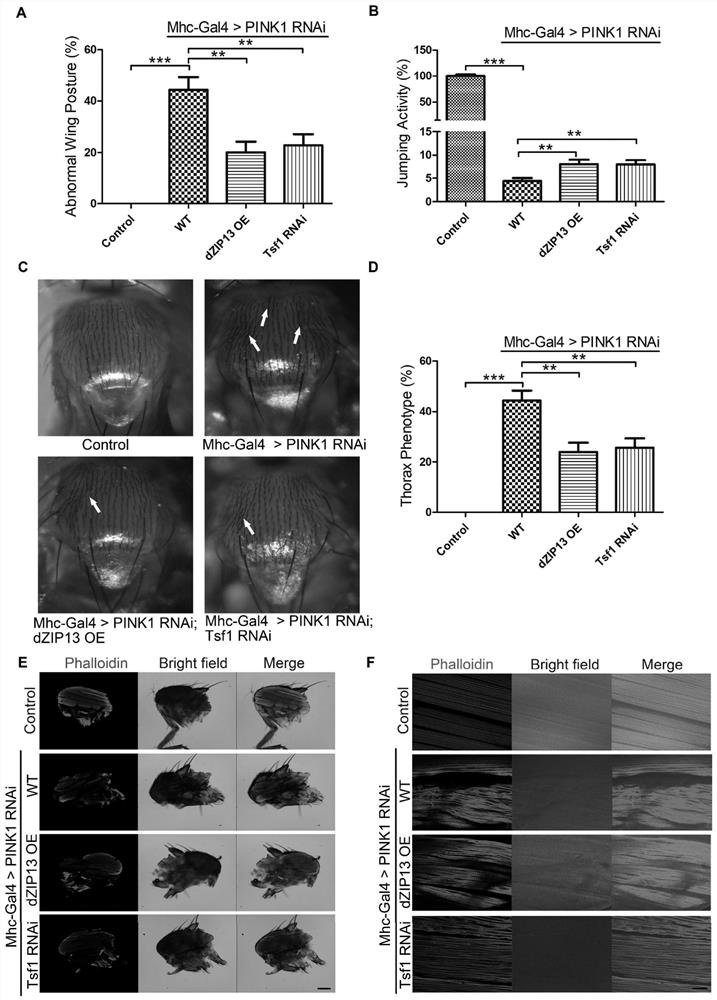Application of iron transporter in treatment of Parkinson's disease
A technology for Parkinson's disease and disease, applied in the field of preparation of gene-targeted drugs
- Summary
- Abstract
- Description
- Claims
- Application Information
AI Technical Summary
Problems solved by technology
Method used
Image
Examples
Embodiment 1
[0054] Embodiment 1: Phylogenetic tree analysis
[0055] Using MEGA software to analyze the phylogenetic tree of human genes ZIP13 and Tsf, and Drosophila genes dZIP13 and Tsf1, it shows that Drosophila dZIP13 and human ZIP13, Drosophila Tsf1 and human Tsf belong to orthologous genes and have the same or similar functions.
Embodiment 2
[0056] Example 2: The acquisition of Tsf1 RNAi and dZIP13 OE transgenic Drosophila strains
[0057] 1. Using the genomic DNA of the wild-type Drosophila w1118 strain as a template, isolate and clone Tsf1 and dZIP13 by PCR, and then introduce them into Escherichia coli competent cells after digestion, ligation, and transformation. Positive clones were obtained through colony PCR, plasmid digestion identification, and sequencing identification.
[0058] 2. Using the wild-type Drosophila w1118 as the recipient, use microinjection technology to transform the constructed plasmid into newborn eggs through the method mediated by p-element. After the eggs develop into adults, number each Drosophila with w1118 After crossing, the red eyes of the offspring fruit flies indicate that the construction is successful.
[0059] Example 2: Effects of Drosophila dZIP13 and Tsf1 genes on PD-like behavior in PINK1-deficient Drosophila
[0060] 1. Effects of dZIP13 OE and Tsf1 RNAi on exercise c...
Embodiment 3
[0064] Example 3: Specific regulation of the expression levels of dZIP13 and Tsf1 in Drosophila muscle tissue can significantly affect mitochondrial respiration
[0065]In this experiment, Mhc-Gal4>+ / + normal group Drosophila, Mhc-Gal4>PINK1 RNAi model Drosophila, Mhc-Gal4>PINK1 RNAi; dZIP13 OE Drosophila and Mhc-Gal4>PINK1 RNAi; Tsf1 RNAi Drosophila trunk Separation is carried out, the supernatant is obtained by homogenization and centrifugation, and the ATP level of the supernatant is detected with a Promega ATP detection kit. Using seahorseXF-24 to detect the respiratory function of mitochondria in muscle, dissect the trunk of Drosophila, add mitochondria extract, use glass homogenizer to homogenize the tissue, and use gradient centrifugation to obtain mitochondrial pellet. The concentration of mitochondria was detected with a Bradford kit, and the mitochondria were added to seahorse 24-well plates. For the detection of mitochondrial complex III respiration, 4 mM sn-glycer...
PUM
 Login to View More
Login to View More Abstract
Description
Claims
Application Information
 Login to View More
Login to View More - R&D Engineer
- R&D Manager
- IP Professional
- Industry Leading Data Capabilities
- Powerful AI technology
- Patent DNA Extraction
Browse by: Latest US Patents, China's latest patents, Technical Efficacy Thesaurus, Application Domain, Technology Topic, Popular Technical Reports.
© 2024 PatSnap. All rights reserved.Legal|Privacy policy|Modern Slavery Act Transparency Statement|Sitemap|About US| Contact US: help@patsnap.com










